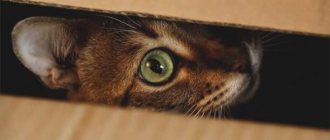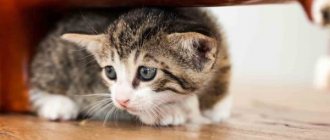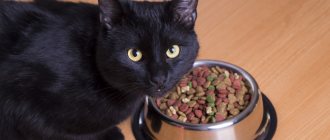Often after lambing, owners witness how a cat carries kittens. There are many reasons for such actions, starting with the owners’ excessive curiosity about furballs, and ending with postpartum eclampsia of the female. To save the lives of the younger generation, you should familiarize yourself with the main provoking factors and methods for eliminating them.
How does a cat carry kittens?
Reasons why a cat hides her kittens
The first surprise when encountering a non-standard event, when a cat carries a kitten in its teeth, quickly passes. The owners begin to worry about the reasons for such an act, despite the instincts inherent in the animal to preserve the offspring at any cost.
After the birth of kittens, the cat may behave inappropriately
Dirty place to live
The nest with newborns may be cold, too hot or too damp. Constant drafts, bright light and close proximity to other animals force the cat to pull out and move the kitten to a safer area.
The second source of pet dissatisfaction can be the pollution of its temporary home. Waste from adult and young animals in the form of feces, sebaceous secretions, hairballs causes a feeling of disgust in the young mother and a desire to change unsanitary conditions to more suitable ones: a clean, dry and warm corner. Sometimes it becomes a blanket on the owner's bed.
Important! Attempts to shake kittens out of the box, replace bedding, or do general cleaning can provoke a conflict and the cat’s refusal to look after and care for the babies.
People's curiosity about newborns
The young mother begins to actively worry when adults and children often approach the nest, when they try to pet the babies or just look. The shelter becomes unreliable, and attention is perceived as a direct threat to the kittens’ health. Those who like to constantly admire their offspring quickly encounter a situation like a cat moving kittens to a more secluded and inaccessible place.
Note! Some individuals manage to move the nest to the mezzanine or attic in a private house. Such secrecy and the desire to hide babies can lead to dire consequences.
If a cat takes the kitten away from the eyes of prying eyes, it means that she is not satisfied with close attention from people.
Closer to food
After reaching one and a half months of age, kittens switch to solid food. Mother's milk alone is not enough for them, so the cat tries to move the nest closer to the source of food - its bowls.
There are several other reasons why a cat drags her kittens from the box to different places.
- Inappropriate nest dimensions. Large or small boxes are not suitable for newborns. In the first case, the animals become unprotected and accessible to external enemies; in the second, they become too small for the normal life of their offspring. In any of the options, the mother begins to search for more suitable living conditions for her brood.
- Features of the breed. Some varieties are distinguished by developed protective instincts. They are manifested by excessive guardianship over babies, constant attempts to move kittens into darkened corners inaccessible to people. This feature is found in Singapore and Bengal cats and is associated with attempts to throw a hypothetical predator off the scent and hide the young from it.
- To attract attention. If the kittens scream too loudly, attracting the attention of the female, then she has to look for corners that are safe for loud-voiced offspring. In the wild, dangerous predators find nests based on the squeaks of blind babies and snack on them with pleasure.
Box too small
- Separating the brood. A weaker kitten needs more care and better conditions for normal development. A caring female is trying to hide a sickly baby in a safe place where he will be better. A common occurrence is when a cat tries to bring one kitten onto the bed or sofa. In this way, she tries to attract the attention of the owners and ask for help; she is unable to solve the current problem on her own.
- Eclampsia. Complicated childbirth provokes an insufficient amount of calcium in the animal’s body. The main symptoms of the disease include increased aggressiveness, fearfulness, irritability and nervousness. Veterinarians consider attempts to take young animals to a new, dark place as a side reaction to the disease.
For your information! The inexperience of a cat that has given birth for the first time can also become a provocateur for a long and confused selection of the best place for the nest. She doesn’t understand at all why newborns constantly scream and demand to be nearby. Confusion plays a cruel joke: the young mother begins to non-stop hide her brood, moving it from the box to the wardrobe and back.
Instincts, character and behavior of cats
Instinct is an inherited quality that encourages the performance of rational actions based on an unconscious impulse. Such automatic signals are controlled by the central nervous system.
The strategy of cat behavior is based on the following instincts:
- self-preservation;
- prolongation of the family;
- territory protection;
- satisfy the feeling of hunger.
Due to the fact that cats are intellectually developed creatures, they have play and communication needs.
The desire to chase a running mouse is inherent in a cat at the genetic level.
In order for the trigger mechanism to work, awakening instincts, an irritating factor is necessary. For example, scratching or rustling sounds are a signal for furry pets to capture a victim.
Any reflex corresponds to a biological purpose and is interconnected with the outside world. Among the most important are hunting, sexual and maternal.
Since, thanks to the food instinct, the animal goes in search of food, it is one of the leading
Scientists combine all the studied instincts into several broad groups.
Table 1. Studied instincts in cats
| Category | Description |
| Ensuring the vitality of the body |
|
| Formative socialization |
|
| Allowing adaptation to the environment |
|
After the birth of kittens, maternal instinct comes to the fore
Animals kept in a limited area lose some of their behavioral patterns. This occurs due to the loss of their original meaning. For example, the hunting instinct undergoes changes in the process of domestication of cats. Running speed, jumping ability, good sense of smell, touch and hearing remain at the proper level, but the desire to catch prey gradually atrophies. The pet gets used to the daily feeding schedule and is not bothered by searching for food on its own.
In domestic cats, territorial and social instincts play an important role, especially maternal instincts. Regardless of the conditions of detention and other components, it does not lose its relevance.
The owner's concern for the pet leads to the extinction of the hunting instinct
Maternal instinct
The behavioral repertoire of a cat that has given birth is based on meticulous care for the offspring.
During pregnancy, in addition to producing the hormone responsible for milk production, the body produces oxytocin. This substance is responsible for the bond between cats and kittens. The mechanism of operation is simple. The smell of the female's amniotic fluid remaining on the babies stimulates recognition of the offspring. Therefore, olfactory signals play a significant role in the first 20 days after birth.
How to tell if a cat is pregnant
Caring for offspring changes with the development of the mental and physical state of children. In its absence, they are stunted in growth. For 3 weeks after giving birth, the female tirelessly looks after the kittens. If they crawl away from the nest, she brings them back. In most cases, kitten dragging is considered normal at this stage. The exception is the restless, repeated shifting of babies from place to place. This is caused by a dangerous postpartum pathology.
Scientists have found that it is safe for a kitten to be kept in a female's teeth. Certain impulses are formed in the animal’s brain that help maintain balance and better orientation in space when carrying offspring. In addition, babies instinctively assume the fetal position and pull their limbs towards their body, providing themselves with additional stability.
When placed in the mother's teeth, the kitten automatically takes on the form of a fetus.
Character traits
In addition to instincts, animals are governed by character. Along with reflexes, cats have a collection of well-developed individual behavioral strategies. The formation of the latter depends on the situation surrounding the animal. Depending on the personality traits of the female, the postpartum behavioral pattern may change.
The human cat loves to make a nest in the owner's bed
Researchers identify 5 types of cat personalities.
Table 2. Varieties of cat characters
| Type | Characteristic |
| Cat-man | Very sociable animals that need constant care. They are attached to the owner and do not skimp on expressions of feelings. They see themselves as family members and try to take part in the daily life of their owners. |
| Hunter cat | Has pronounced hunting instincts. Constantly chases birds, mice and enthusiastically runs after toys. Doesn't feel well in confined spaces. Needs walking. |
| cat-cat | He prefers spending time with representatives of the cat family to communicating with people. He likes to live in a couple and does not get bored in an empty apartment. Pets of this type can often be found rubbing noses with their own kind. |
| Grumpy cat | The most aggressive and independent type. He feels like the owner of the territory and does not allow encroachments on his property. Doesn't like to play with people, rejects affection. |
| Curious cat | Constantly absorbed in exploring the surrounding space, using the senses of smell and touch. Perceives new people positively and strives to be outside the home. An inquisitive mind often leads to a loss of control over a situation. |
Most cats have the ability to learn from their own mistakes and avoid repeating negative experiences. There is a theory that pets play out several possible options in their minds before performing any action.
Cats belong to the category of intellectually developed animals
Options for undesirable consequences
There is a certain danger in the fact that a cat periodically hides kittens. Incorrect grip or an accidental fall can be fatal for a squeaking lump.
Kitten Trauma
Why does a cat eat its kittens: natural and pathological reasons
While dragging, the cat clenches its teeth tightly, holds the baby by the scruff of the neck, or drags an older kitten across the floor. This type of travel can cause serious injury.
Important! Attempting to take a kitten away from a cat will not lead to a good result, as the cat will clench its jaws more tightly and seriously injure the kitten.
Mother's trauma
Difficult childbirth and postpartum depression negatively affect the physical and mental health of your furry pet. An inadequate animal can drag its offspring to the point of serious injury or forget about its existence, dooming the babies to death.
Death of a kitten
Fatalities occur for several reasons:
- falling from height. When trying to drag, the animal may drop the baby, and such a fall for the newborn will be incompatible with life;
- forgetfulness. Frequent changes of nest locations lead to the loss of several kittens, which quickly die without warmth and food.
Important! Attempts to take the babies by force end in mental disorders in the cat. Additional stress can become a source of hatred for a young mother towards her children and lead to the deliberate destruction of the brood.
In any case, the cat’s behavior shows its concern for the kittens.
How to diversify your cat's diet
You cannot feed your cat only meat and meat products. It is very useful to supplement his diet with a variety of cereals (rolled oats, buckwheat, rice, millet). You need to boil porridge in water, although you can use broth from lean meat. Experts recommend adding a little natural vegetable oil to this mixture, this improves the functioning of the animal’s intestines.
Low-fat fermented milk products are also beneficial for domestic cats - yogurt without additives, kefir or sour cream with a fat content of no more than 9%. Contrary to popular belief, milk is absolutely not healthy for cats, and sometimes even harms digestion.
For your pet’s well-being, it is better not to mix meat and dairy products, for example, give porridge with meat and vegetables at lunch, and a bowl of low-fat yogurt or yogurt in the evening.
Cats love domestic eggs, but they should not be given in large quantities either; excess protein can lead to health problems. A raw quail egg can be offered to the cat as a whole, but only the yolk can be given from a boiled chicken egg.
Is it possible to give raw meat to a cat, and what should it be combined with? Vegetables are great. Your pet's diet can be quite varied. If taught from an early age, the cat will eat boiled vegetables (beets, carrots, cauliflower, zucchini) well. They are mixed with meat or boiled fish.
However, there are quite serious restrictions on mixing feed and natural nutrition.
Examples of what owners should do
The cat hides in dark places - the main reasons and what the owner should do
Constantly dragging young animals around the house requires the owners to take urgent measures. Delay can lead to dire consequences for the cubs. Experienced cat owners recommend the following algorithm of actions:
- Start prenatal preparation of a suitable area for raising babies. To do this, you need to determine the area where the pregnant woman will feel comfortable. This is where the nest is organized.
- Convince all household members in advance of the dangers of close attention. A pregnant mother should feel safe and not be stressed by every prying glance.
- Visit your veterinarian before labor begins. The specialist will examine the cat and prescribe multivitamin complexes that will help prevent the development of postpartum eclampsia.
A comfortable house needs to be prepared before giving birth
Important! Attempting to scold or punish a young and inexperienced cat who is busy carrying kittens will lead to a loss of trust. Relocating the brood on your own can cause the animal to abandon its own babies. Mothers have natural instincts to preserve their offspring; any interference will be perceived as a direct threat.
The best places for a mother with kittens
As soon as the cat begins to hide, worry and be in the most unexpected corners, the owner must take care of arranging a house for future offspring. If you ignore this question, then the meeting with the kids will happen in an unexpected place: in the wardrobe, in clean bed linen, or while the cat is dragging the kitten.
Veterinarians recommend adhering to the following principles:
- a few days before the expected birth, create several nests and place them in darkened corners of the house. After selecting a specific house, the rest must be deleted;
- By nest we mean a box, basket or ready-made house, sold in any pet store. The inner and outer surfaces should be lined with soft fabric, the bottom should be made of a more durable material and covered with diapers. Some owners prefer to use exhibition tents that have doors. They can be closed, thereby preventing the cat from dragging newborns around the apartment;
- The optimal temperature in the room where the nest is located is 28 °C. For additional heating, infrared lamps with a power of 250 W are used. Cold weather has a bad effect on the well-being of children and causes them to develop various colds. When a kitten's body temperature drops below 35 °C, aspiration pneumonia occurs, often resulting in death.
A cat has its own opinion on convenience and the safety of the nest, regardless of the person’s opinion. If something doesn’t suit her, she will survey the entire territory and find the ideal corner for herself. After choosing a nest, the young mother will begin to move the young one at a time. Having finished exploring a new area, the cat decides whether it is suitable for life. If she is not satisfied with something, the search will begin again.
The innate instinct of any cat is to give birth, care and feed its helpless babies. Human intervention is required in some cases, especially if the animal is not happy with the selected area. Only in this case, the pet needs to be helped unobtrusively and delicately, so that she does not perceive the assistant as a hindrance. This approach will calm the cat, preserve the life and health of the kittens, without causing additional inconvenience.









